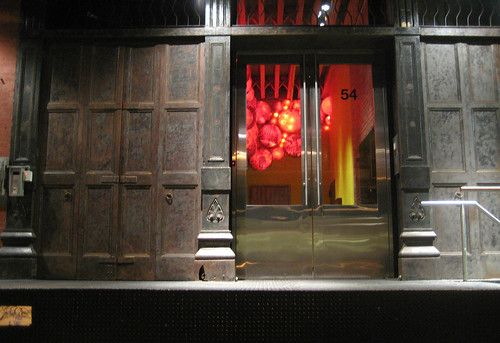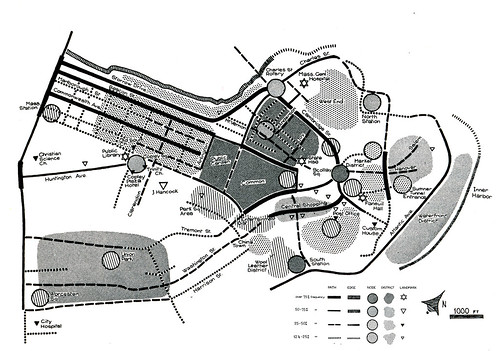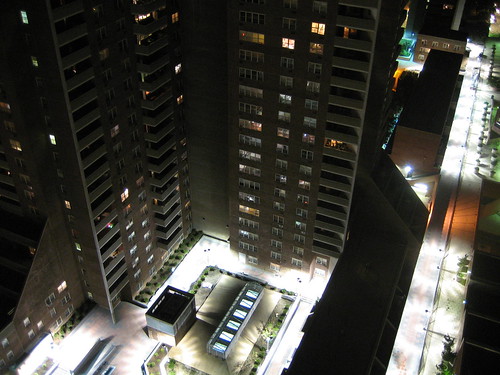triangle below canal
This weekend I spent an evening in TriBeCa, marking the first time that I've spent more time than it takes to eat a meal in the area. Despite being bordered by the vibrant neighborhoods of SoHo and Greenwich Village, TriBeCa lacks the consistent sense of place present in most other Manhattan neighborhoods. Despite a ton of awesome restaurants and some really outstanding industrial buildings, TriBeCa always feels empty to me.

In his book The Image of the City (1960), Kevin Lynch produces maps by interviewing residents of Boston and asking them to sketch the city's layout. He divides the urban structures people describe into 5 categories: Paths, Edges, Districts, Nodes, and Landmarks. The distinctions between categories can be fuzzy sometimes -- the Brooklyn Bridge, for example, has the characteristics of both a path and a landmark -- but overall these 5 categories are a very effective way of describing urban space.
 Map of Boston by Kevin Lynch derived from interviews with Bostonians.
Map of Boston by Kevin Lynch derived from interviews with Bostonians.
TriBeCa is defined by its edges. Even the name -- Triangle Below Canal -- comes from its northern boundary, not a landmark like Flatiron or a geographic characteristic like Cobble Hill. It is this lack of a uniting feature, geographic or constructed, which causes TriBeCa to feel so decentralized and empty. While I'm reluctant to make a normative judgement and say that this is a 'bad' thing, I do think that every neighborhood deserves a heart.

As with virtually every other neighborhood in New York, TriBeCa is growing rapidly. New buildings in the area are generally high rise apartment buildings without a lot of character. I suppose it's OK to have one neighborhood in Lower Manhattan without a bustling street life, but I don't see how helping TriBeCa to develop a more cohesive feel could make the area worse.

As millions of dollars are poured into the World Trade Center on the southern border of this neighborhood, planners might want to think about TriBeCa as more than just a geometric form. On the other hand, maybe the neighborhood could use a square.

In his book The Image of the City (1960), Kevin Lynch produces maps by interviewing residents of Boston and asking them to sketch the city's layout. He divides the urban structures people describe into 5 categories: Paths, Edges, Districts, Nodes, and Landmarks. The distinctions between categories can be fuzzy sometimes -- the Brooklyn Bridge, for example, has the characteristics of both a path and a landmark -- but overall these 5 categories are a very effective way of describing urban space.
 Map of Boston by Kevin Lynch derived from interviews with Bostonians.
Map of Boston by Kevin Lynch derived from interviews with Bostonians.TriBeCa is defined by its edges. Even the name -- Triangle Below Canal -- comes from its northern boundary, not a landmark like Flatiron or a geographic characteristic like Cobble Hill. It is this lack of a uniting feature, geographic or constructed, which causes TriBeCa to feel so decentralized and empty. While I'm reluctant to make a normative judgement and say that this is a 'bad' thing, I do think that every neighborhood deserves a heart.

As with virtually every other neighborhood in New York, TriBeCa is growing rapidly. New buildings in the area are generally high rise apartment buildings without a lot of character. I suppose it's OK to have one neighborhood in Lower Manhattan without a bustling street life, but I don't see how helping TriBeCa to develop a more cohesive feel could make the area worse.

As millions of dollars are poured into the World Trade Center on the southern border of this neighborhood, planners might want to think about TriBeCa as more than just a geometric form. On the other hand, maybe the neighborhood could use a square.

1 comment:
I was under the impression that Tribeca was valued by its residents precisely because it feels so empty on the street.
Isn't it peopled mostly by wealthy loft-owners seeking privacy? It's the place rich-downtown types run away from Soho to, isn't it?
Post a Comment